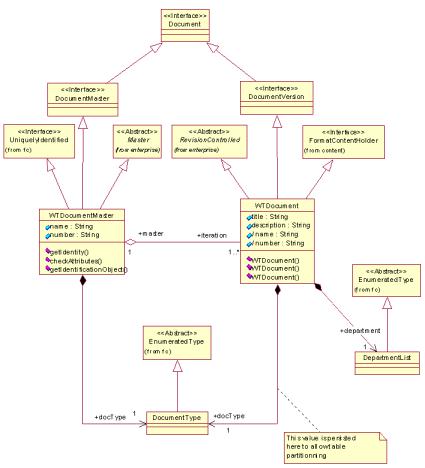Document Abstractions
The wt.doc package provides a standard implementation of managed documents. A simplification of the document model is shown below. This simplification shows some of the core interfaces that make up WTDocument and WTDocumentMaster. These objects actually implement a number of interfaces to acquire their behavior. To see the full scope of interfaces that are implemented by these two objects go to the Javadoc for wt.doc.WTDocument and wt.doc.WTDocumentMaster.
Doc Package
The document classes are implemented based on the pattern established for revision controlled objects in the wt.enterprise package. These classes, WTDocumentMaster and WTDocument, provide concrete classes exhibiting the management characteristics established in wt.enterprise and add specifics for documents. The properties of a document are specified on the WTDocument class. Then, for normalization purposes, the sum of the properties are stored on the WTDocumentMaster. More specifically, WTDocument implements Format ContentHolder to give it a primary content item and multiple secondary content items. WTDocument can create two types of relationships to other documents. The first, WTDocumentUsageLink, is similar to the WTPartUsageLink in that it also subclasses IteratedUsageLink. It does not have a quantity. WTDocumentUsageLink is used to create uses relationships between documents or document structure. Documents should use this if a document is made up of sub-documents and the sub-documents can be reused by other documents, or need to be controlled separately. Similar to the part implementation, the WTDocumentService has convenience methods for navigating this relationship and there is a WTDocument ConfigSpec to filter results. The second, WTDocumentDependencyLink implements IteratedDescribeLink which is also implemented by WTPartDescribeLink. This is a version-specific relationship between two documents. This relationship is shown in the client as references. A reference between two documents can be created to show a dependency on another document. A document may reference some information in another document, so during a create or update, a reference to that document is added. The references relationship has a comment attribute that can be used to explain why the reference exists or what the dependency is. WTDocument Service also has convenience methods for navigating the WTDocumentDependencyLink.
The doc package is an example of implementing a Revision Controlled Business subclass. The concrete document business classes inherit from the Revision Controlled Business model (Master and RevisionControlled) template in the enterprise model. Document inherits most of its functionality from the enterprise object RevisionControlled. RevisionControlled pulls together many plug and play functionality interfaces. To see the full list of interfaces go to wt.enterprise.Revisioncontrolled in the javadoc. In particular, it includes interfaces from the content package. This means that a WTDocument is a content holder; that is, it can have files or URLs included in it.
Attributes are on either WTDocumentMaster or WTDocument. Attributes on WTDocumentMaster have the same value for all versions and iterations. If an attribute on the master changes after several versions and iterations have been created, the change is reflected in all the versions and iterations. Attributes on WTDocument can generally have different values for each iteration, so changes impact only one iteration. This is why content holder is implemented on DocumentIteration.

